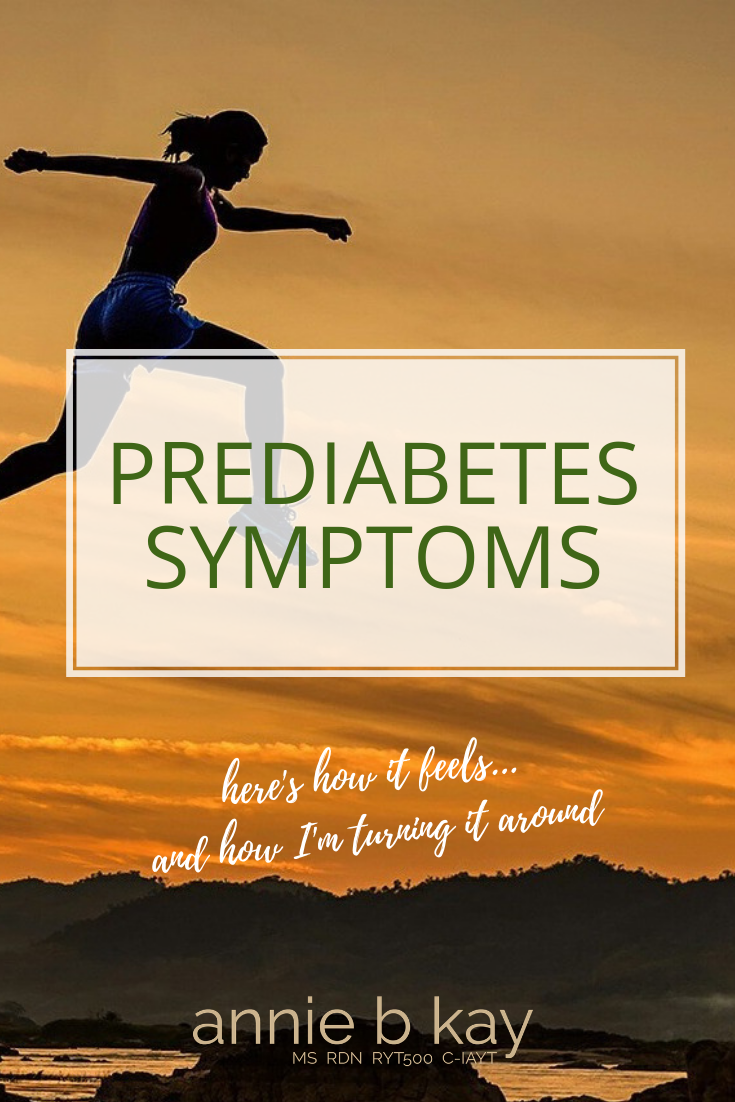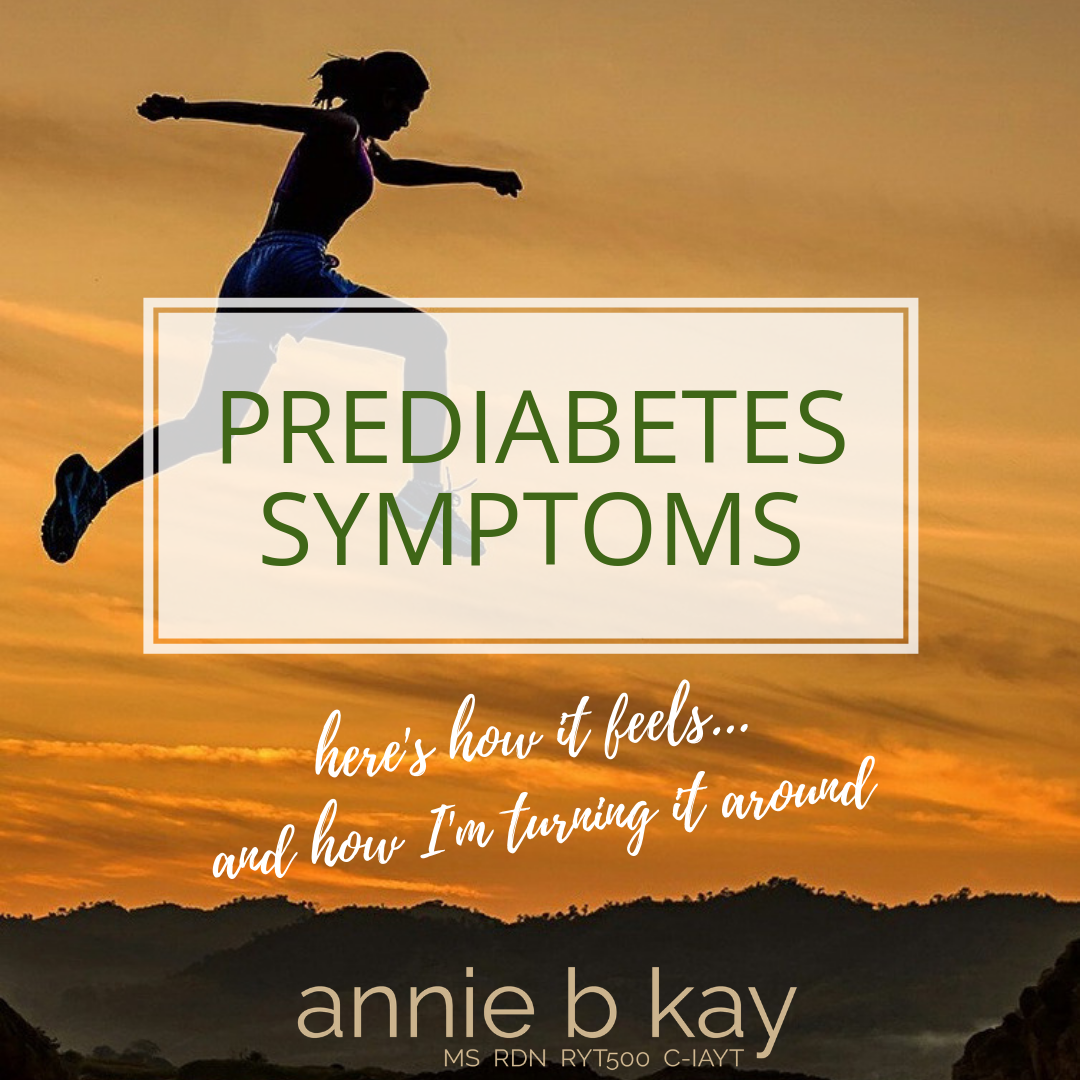The last couple years have been tough. Through my challenging time, I had a personal experience of how prediabetes symptoms feel – I don’t recommend it. For me, it was the wake-up call I needed to refocus on lifestyle.
One indicator of how life is going generally is my eating – for years I had it together, surfing life’s ups and downs while my relationship with food was stable and happy. It helped that I work at a yoga center famous for its healthful food, and that I’ve studied nutrition for almost 30 years (still fascinated!). Being an “expert” actually heightens the misery – I’m sure many of you know of what I speak.
Over the past two years, when I realized several of those big life fears (I watched the love of my life die, quick and gruesome…then…he came back to life! wait, wha?), the place that slipped was eating (of course!). In my despair, movement-related self-care was also just too hard to keep up. I moved a little but not enough – and I just could not find the joy I always felt with dance, movement and fitness.
Through this time, my A1c crept up. While I know in great detail how to address it (hello, moderating carbohydrates and moving more) it hasn’t been easy. My progress until now has been rather slow. One thing that I’ve experienced (I think) is how someone feels when their blood sugar is on what I call the blood sugar roller-coaster, giving you prediabetes symptoms. It is a profound feeling and impacted nearly every moment of my day, and has a set of unhelpful thoughts attached.
Prediabetes Symptoms
While many people with prediabetes do not have symptoms, here are a few that can happen.
Fatigue. First, you’re tired. Really tired and unmotivated. It’s hard to comprehend a reason to get up and out of bed, and why-botherism is right there, pretty much all the time. There are moments of light, but mostly grey. Tired and unmotivated.
Unwellness. Then, you feel sort of crummy. Most of the time. Low energy and achy deep inside for no real reason.
Increase Thirst & Urination. I’ve always been a water drinker and didn’t notice this one, but some folks do.
Weird things begin to happen physically – blurred vision, skin things, digestive things, that have never happened before and don’t help with moving forward.
Cravings. For me, eating my favorite comfort/trigger foods (starch for me – mashed potatoes) became a heightened experience. I got trapped in a familiar cycle of emotional eating – stress, think of mash potatoes – eat mashed potatoes, overeat mashed potatoes – wish I hadn’t eaten mashed potatoes as I feel over-full.
What to Do if You Have Prediabetes Symptoms
Get ye to your doctor. Have labs drawn. According to the Centers for Disease Control and Prevention (CDC), more than 1 in 3 Americans have prediabetes, and 90% of those that don’t know it.
Know that it’s action time.
Gather helpers. My counselor/therapist – weekly through the worst of it, gave me someone to get into the muck with – to go deep deep into my fears and feel them, honor them. I could never have moved on or begun to release my fears around losing my dude without her.
Find yourself a good dietitian. Every town has at least one excellent dietitian – that’s is the right fit for your personality and pocketbook. More dietitians take health insurance, and more dietitians also offer premium services like custom fitness routines, custom meal plans, and seriously regular meetings.
What is Prediabetes Anyway?
Prediabetes is when you begin to have problems with your blood sugar but you are not quite to the place of having a diagnosis of diabetes. It is action time, my friend.
Specifically, by the numbers, prediabetes is when:
- A1c (a measure of blood sugar over several months) between 5.7 -6.4%
- A fasting blood glucose of between 100-124 mg/dL
There are other indicators, like an oral glucose tolerance test, blood lipid levels that can also point to your risk of having prediabetes.
Here is a quiz on risk factors from the American Diabetes Association.
Why do I say it is action time? Because you can change it.

Update – My Story
At times, progress seemed a game of inches – sort of exasperating. It does, as you might imagine, heighten the excitement to also be an expert in the field. That’s where self-compassion comes in. Then, as I tried to show up for my own life, and my family’s life, over and over day after day, it began to slowly shift. I had a great leap forward – normal labs! Now, I’m feeling better, eating better. My mindset is better and I’m heading in the right direction. I just show up, over and over, and participate in my own life (I wasn’t for a while). Recovery is one step forward, one step back. Sometimes it’s two steps forward, one step back and I do my best to notice and celebrate that.
Everyone, when it comes to health and well-being, has both unique challenges and resources. I am not recovering without support and friends. I have support from the medical community – I live in the great state of MA – a place that attempts to provide care for all – and that care for me (and my husband) has been nothing less than life-saving. I have access to mental health and physical health care.
Take Your Next Step
As part of my healing and hopefully helping, I am now in private practice – both telehealth and face-to-face in Great Barrington, MA. Find out more about my personal lifestyle coaching.
Tell Me
What’s your story? What are the challenges and resources you have to heal your life? I want to know!




Fantastic post! Love how you broke everything down in such an easy to understand way!
Thanks Lindsey!
Awesome! We just wrote a similar post on our blog about the symptoms of hypothyroidism 🙂 Love these types of articles! So helpful <3.
Thanks Erica!
Thanks for sharing your experience! I’m sure this wasn’t easy to talk about. Being in the nutrition space makes you feel like “you should have it all together, all the time”. It’s not always that simple and we’re human and complex like any other patient we might work with.
Thanks Stacey! Yes I’ve found that while it is definitely a tender place to go, that you’re not always the picture of perfect health despite all your training, it’s helpful – we are all just humans doing the best we can.
Annie, thank you for sharing your journey! It can help so much to read someone else’s stories!
Thank you Didi. Glad it helps.
Thank you for sharing part of your story – I know it can definitely help people going through a similar experience. This was a really informative post about something that needs to be on more people’s radar!
Thank you Shannon!
Thanks Annie! So many people struggle with prediabetes symptoms and are unaware. Very helpful! . So refreshing to see a personal account. I just wrote a similar post about autoimmune diseases
Yes – people don’t know why they feel poorly. Nutrition to the rescue!
Very informative!
Thanks Kara!
We’ve had so many individuals having questions about prediabetes. This article is a great resource to have in our files. Thank you!
O is that the famous and fabulous Bronte? Thank you!
Fantastic article!! So helpful and thank you so much for sharing your personal story, that isn’t always easy.
Great post! Thank you for the insightful article. I would like to include a little bit more information that long-term hyperglycemia during diabetes causes chronic damage and dysfunction of various tissues, especially the eyes, kidneys, heart, blood vessels, and nerves.
Thanks thanks
My pleasure